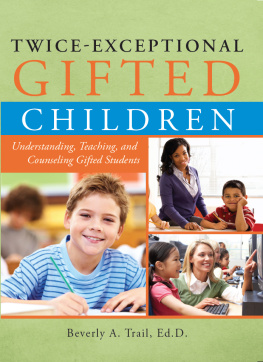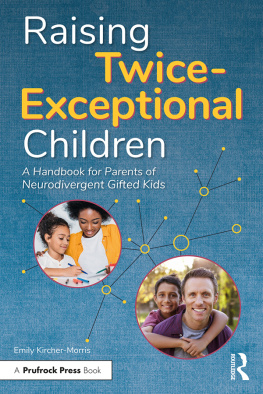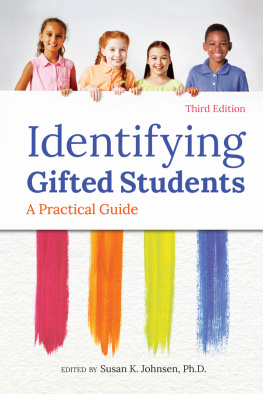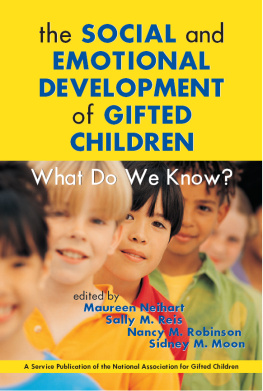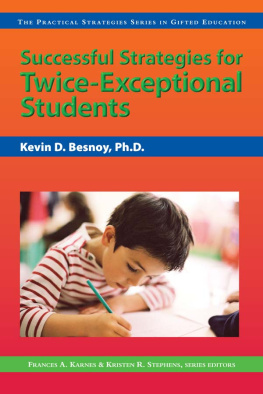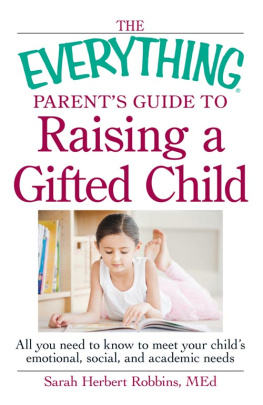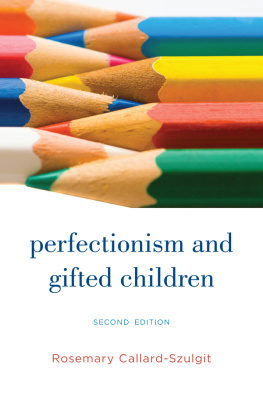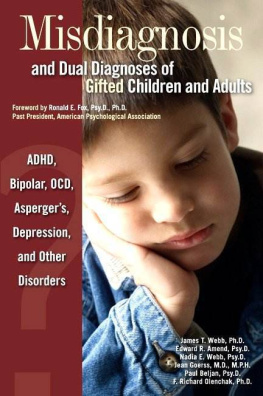Beverly A. Trail - Twice-Exceptional Gifted Children
Here you can read online Beverly A. Trail - Twice-Exceptional Gifted Children full text of the book (entire story) in english for free. Download pdf and epub, get meaning, cover and reviews about this ebook. publisher: Taylor and Francis, genre: Home and family. Description of the work, (preface) as well as reviews are available. Best literature library LitArk.com created for fans of good reading and offers a wide selection of genres:
Romance novel
Science fiction
Adventure
Detective
Science
History
Home and family
Prose
Art
Politics
Computer
Non-fiction
Religion
Business
Children
Humor
Choose a favorite category and find really read worthwhile books. Enjoy immersion in the world of imagination, feel the emotions of the characters or learn something new for yourself, make an fascinating discovery.
- Book:Twice-Exceptional Gifted Children
- Author:
- Publisher:Taylor and Francis
- Genre:
- Rating:3 / 5
- Favourites:Add to favourites
- Your mark:
- 60
- 1
- 2
- 3
- 4
- 5
Twice-Exceptional Gifted Children: summary, description and annotation
We offer to read an annotation, description, summary or preface (depends on what the author of the book "Twice-Exceptional Gifted Children" wrote himself). If you haven't found the necessary information about the book — write in the comments, we will try to find it.
Twice-Exceptional Gifted Children — read online for free the complete book (whole text) full work
Below is the text of the book, divided by pages. System saving the place of the last page read, allows you to conveniently read the book "Twice-Exceptional Gifted Children" online for free, without having to search again every time where you left off. Put a bookmark, and you can go to the page where you finished reading at any time.
Font size:
Interval:
Bookmark:

Copyright 2011 Prufrock Press Inc.
Edited by Lacy Compton
Production Design by Marjorie Parker
ISBN-13: 978-1-59363-738-5
No part of this book may be reproduced, translated, stored in a retrieval system, or transmitted, in any form or by any means, electronic, mechanical, photocopying, microfilming, recording, or otherwise, without written permission from the publisher.
At the time of this books publication, all facts and figures cited are the most current available; all telephone numbers, addresses, and website URLs are accurate and active; all publications, organizations, website, and other resources exist as described in this book; and all have been verified. The author and Prufrock Press make no warranty or guarantee concerning the information and materials given out by organizations or content found at website, and we are not responsible for any changes that occur after this books publication. If you find an error or believe that a resource listed here is not as described, please contact Prufrock Press.
 | Prufrock Press Inc. P.O. Box 8813 Waco, TX 76714-8813 Phone: (800) 998-2208 Fax: (800) 240-0333 http://www.prufrock.com |
TWICE-EXCEPTIONAL
GIFTED
CHILDREN
T hrough years of experience teaching gifted students in the public school system and working as a district gifted consultant, twice-exceptional consultant, district gifted education coordinator, and state twice-exceptional consultant/trainer, I realized that while some gifted students were achieving in school many other equally gifted students were not. I was motivated by a desire to understand the reasons why some gifted students become valedictorian of their class while other gifted students underachieve and even drop out of school. My quest to understand has resulted in a M.A. in gifted education and an Ed.D. in special education. Through this journey, I began to realize some gifted learners had significant cognitive discrepancies in their abilities. Although they had incredible strengths, these gifted learners, known as twice-exceptional learners, also had mild to moderate disabilities. When it came time to choose a topic for my doctoral dissertation, I decided to conduct a qualitative study focusing on gifted students with disabilities. The insights I gained from an extensive review of the literature and my research has helped me to gain an in-depth understanding of factors that influence the manifestation of gifted potential.
The failure of some of our most creative and brightest gifted students to develop their potential is a national tragedy. Cognitive discrepancies, asynchronous development, and unique learning styles combined with teachers misconceptions and stereotypical notions put these gifted students at risk. Gifted students with exceptional verbal skills can have a difficult time expressing their thoughts in writing. They may be able to solve complex mathematical problems, but cannot learn the multiplication tables or pass timed skill tests. These children have knowledge of concepts well beyond their years, yet cannot complete assignments in a timely manner. Twice-exceptional learners can underachieve for years before their struggles are noticed. Unfortunately, more often than not their underachievement is attributed to lack of effort and punitive measures are implemented. As their frustration increases, social and emotional problems emerge. Behavior problems can become the focus of interventions.
This book compiles the most recent research on gifted students with disabilities into a comprehensive, easy-to-use guide. Administrators, classroom teachers, parents, and gifted and special education teachers/specialists can use this book to develop a broad understanding of the complex issues associated with gifted students who have disabilities. The chapters can guide a collaborative team step-by-step through the process of identifying student needs, selecting strategies, and developing a comprehensive plan to meet the diverse needs of twice-exceptional children.
T wice-exceptional learners (gifted students with disabilities) continue to be a misunderstood, misjudged, and neglected segment of the student population (Bianco, 2005; Brody & Mills, 1997; Cline & Schwartz, 1999; Davis & Rimm, 2004; Karnes, Shaunessy, & Bislan, 2004; Whitmore & Maker, 1985). For years, gifted and special education students were thought to be at opposite ends of the intelligence spectrum. It was not until the 1970s that educators realized gifted students also could have disabilities. James J. Gallagher coined the term twice-exceptional to denote students who are both gifted and have disabilities (Coleman, Harradine, & King, 2005). Masked disabilities make aspects of academic achievement difficult for these gifted students. Identification of students who are twice-exceptional is difficult because their strengths and weaknesses mask each other, creating a unique learner profile. The profiles of twice-exceptional students are atypical of a gifted student or a student with disabilities. The educational needs of twice-exceptional students tend to be overlooked when the students are assessed for either gifted or special education services because their special characteristics are not considered in the separate identification protocols (Brody & Mills, 1997). Often the disabilities and/or gifted potential remain unnoticed for years while the student level of frustration continues to increase.
The important concepts discussed in each chapter are summarized in the overview below. The chapters build on each other to create a comprehensive understanding of what twice-exceptional learners need in order to be successful in school.
Chapter 1: Unique Learners
- Twice-exceptional learners have the characteristics of gifted students and students with disabilities.
- There is no federal definition for twice-exceptional learners to guide the identification process.
- Unique characteristics can make it difficult for twice-exceptional learners to qualify for either gifted or special education services.
- Twice-exceptional learners are at risk when services are delayed.
Chapter 2: Response To Intervention
- Response to intervention can be effectively implemented to meet the diverse needs of twice-exceptional learners.
- It is a collaborative process involving classroom teachers, gifted education specialists, special education specialists, parents, students, and other specialists or administrators as needed.
- The problem-solving process provides a comprehensive structure to define student needs, plan interventions, implement the plan, monitor students progress, and make sure the plan is modify accordingly.
- Tiers of interventions include specific strategies at the universal, targeted, and intensive levels.
Chapter 3: Continuum of Needs and Services
- Determine the risk and resiliency factors that are influencing the students achievement in a positive or negative way.
- Review qualitative and quantitative data to get a clear understanding of the students abilities and disabilities. Recommend additional assessments if needed.
- Define the individual students strengths and challenges.
- Identify learner needs and develop measurable goals that will guide interventions.
Font size:
Interval:
Bookmark:
Similar books «Twice-Exceptional Gifted Children»
Look at similar books to Twice-Exceptional Gifted Children. We have selected literature similar in name and meaning in the hope of providing readers with more options to find new, interesting, not yet read works.
Discussion, reviews of the book Twice-Exceptional Gifted Children and just readers' own opinions. Leave your comments, write what you think about the work, its meaning or the main characters. Specify what exactly you liked and what you didn't like, and why you think so.

